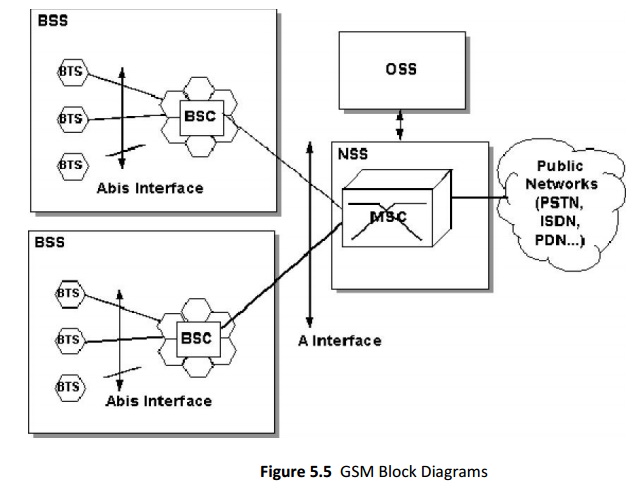Chapter: Satellite Communication : Satellite Applications
Mobile satellite services
Mobile satellite
services:
GSM:
Services and Architecture:
If
your work involves (or is likely to involve) some form of wireless public
communications, you are likely to encounter the GSM standards. Initially
developed to support a standardized approach to digital cellular communications
in Europe, the "Global System for Mobile Communications" (GSM)
protocols are rapidly being adopted to the next generation of wireless
telecommunications systems.
In
the US, its main competition appears to be the cellular TDMA systems based on
the IS-54 standards. Since the GSM systems consist of a wide range of
components, standards, and protocols.
The
GSM and its companion standard DCS1800 (for the UK, where the 900 MHz
frequencies are not available for GSM) have been developed over the last decade
to allow cellular communications systems to move beyond the limitations posed
by the older analog systems.
Analog
system capacities are being stressed with more users that can be effectively
supported by the available frequency allocations. Compatibility between types
of systems had been limited, if non-existent.
By
using digital encoding techniques, more users can share the same frequencies
than had been available in the analog systems. As compared to the digital
cellular systems in the US (CDMA [IS-95] and TDMA [IS-54]), the GSM market has
had impressive success. Estimates of the numbers of telephones run from 7.5
million GSM phones to .5 million IS54 phones to .3 million for IS95.
GSM
has gained in acceptance from its initial beginnings in Europe to other parts
of the world including Australia, New Zealand, countries in the Middle East and
the far east. Beyond its use in cellular frequencies (900 MHz for GSM, 1800 MHz
for DCS1800), portions of the GSM signaling protocols are finding their way
into the newly developing PCS and LEO Satellite communications systems.
While
the frequencies and link characteristics of these systems differ from the
standard GSM air interface, all of these systems must deal with users roaming
from one cell (or satellite beam) to another, and bridge services to public
communication networks including the Public Switched Telephone Network (PSTN),
and public data networks (PDN).
The GSM architecture includes
several subsystems:
The Mobile Station (MS) --
These digital telephones include vehicle, portable and hand-held terminals. A
device called the Subscriber Identity Module (SIM) that is basically a
smart-card provides custom information about users such as the services they've
subscribed to and their identification in the network
The Base Station Sub-System (BSS)
-- The BSS is the collection of devices that support the switching networks
radio interface. Major components of the BSS include the Base Transceiver
Station (BTS) that consists of the radio modems and antenna equipment.
In
OSI terms, the BTS provides the physical interface to the MS where the BSC is
responsible for the link layer services to the MS. Logically the transcoding
equipment is in the BTS, however, an additional component.
The Network and Switching
Sub-System (NSS) -- The NSS provides the switching
between the GSM subsystem and external networks along with the databases used
for additional subscriber and mobility management.
Major
components in the NSS include the Mobile Services Switching Center (MSC), Home
and Visiting Location Registers (HLR, VLR). The HLR and VLR databases are
interconnected through the telecomm standard Signaling System 7 (SS7) control
network.
The Operation Sub-System (OSS)
-- The OSS provides the support functions responsible for the management of network
maintenance and services. Components of the OSS are responsible for network
operation and maintenance, mobile equipment management, and subscription
management and charging.

Several channels are used in the
air interface:
FCCH
- the frequency correction channel - provides frequency synchronization
information in a burst
SCH -
Synchronization Channel - shortly following the FCCH burst (8 bits later),
provides a reference to all slots on a given frequency
PAGCH -
Paging and Access Grant Channel used for the transmission of paging information
requesting the setup of a call to a MS.
RACH -
Random Access Channel - an inbound channel used by the MS to request
connections from the ground network. Since this is used for the first access
attempt by users of the network, a random access scheme is used to aid in
avoiding collisions.
CBCH -
Cell Broadcast Channel - used for infrequent transmission of broadcasts by the
ground network.
BCCH -
Broadcast Control Channel - provides access status information to the MS. The
information provided on this channel is used by the MS to determine whether or
not to request a transition to a new cell
FACCH -
Fast Associated Control Channel for the control of handovers
TCH/F -
Traffic Channel, Full Rate for speech at 13 kbps or data at 12, 6, or 3.6 kbps
TCH/H -
Traffic Channel, Half Rate for speech at 7 kbps, or data at 6 or 3.6 kbps
Related Topics